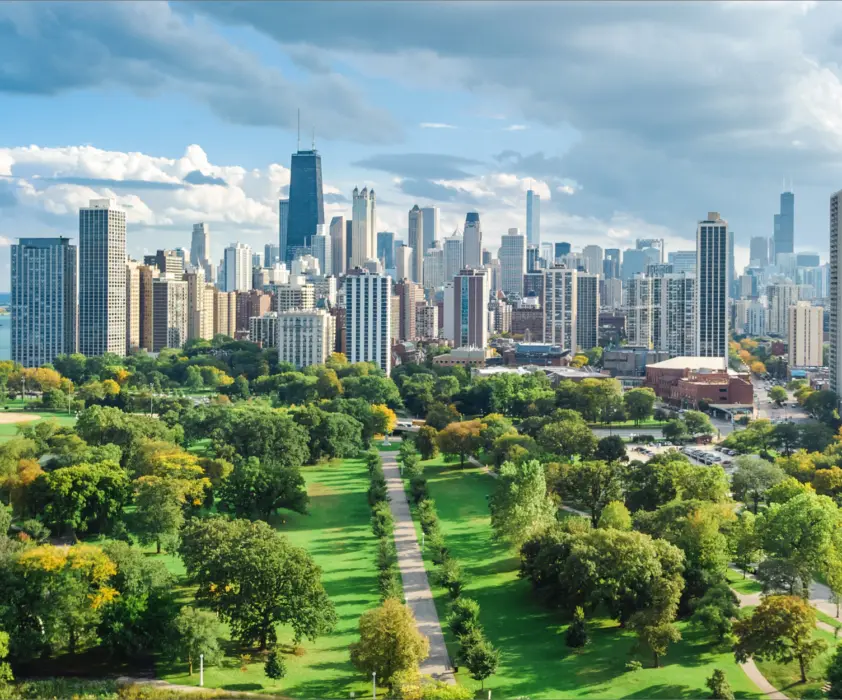
It’s April 21st and I’m sitting in La Porte, Indiana at my home office – five weeks since I last walked into my West Loop office. We bought this lake house as a summer vacation spot for our growing family and have never spent more than three days here. Our family decided that after two days at our West Loop condo, a rural town in Indiana was a safer place to hide out until this novel virus, COVID-19, passes.
In early March, the media appeared to be concerned that this virus would cause a global pandemic, but only 6,000 people had tested positive in the US. A small dose of fear was circulating in Chicago, so we packed a week’s worth of belongings and jumped in the car. Five weeks later, there are 795,000+ confirmed cases, the President is holding daily press conferences, nearly every state has enacted a shelter-in-place order, and 22 million people have filed for unemployment. Our one-week supply of belongings is now going to have to last at least another month.
It is hard to believe that only a few months ago, unemployment was at an all-time low, the only Corona Americans acknowledged was in a clear glass bottle and the term ‘flattening the curve’ was reserved for quantitative math. And although real estate professionals have been predicting a market correction for years (Sam Zell being the loudest voice), I don’t think any of them imagined that a global pandemic would be the source.
I am 36 years old and have lived in Chicago my entire life. I have been a commercial real estate broker since 2006, focused primarily on office. I have worked for two publicly traded companies and two privately held companies. I have now worked through one global recession (with a publicly traded company) and am living through the current correction/recession/depression/to be determined (with a privately held company). I have been asked a lot of questions over the past five weeks and have finally decided to put pen to paper on my responses. The following is my opinion based on information I have read, events I have experienced and most importantly my personal beliefs of what might happen. I am not an economist or scientist. I am a Millennial real estate junkie who has been asked to share his opinion about the Chicago real estate market. I hope this helps someone out there.
Hopefully, none of us will ever experience anything like a global pandemic again but I do believe what we experience will make us better professionals, and more importantly, better human beings.

Adam Showalter
Managing Director
The Future of Office
I have watched the industry change significantly over the past 14 years. The most dramatic changes have been suburban-to-urban migration, the death of the private office and the evolution of collaborative space. Oddly enough, I believe all three of these once future-facing trends will revert in some form or fashion.
Suburbanization
If you are single, recently married or have a kid(s) under five, the city is the place to be. They would say the $30,000 kindergarten or the second kid will push you to the suburbs. They will now say the coronavirus pushed me to the suburbs. For anyone that has spent the past month (and likely more coming) confined to your city apartment, condo, townhouse or SFH, the suburbs suddenly look like utopia. I believe this because I’m living it.
Prior to the pandemic our plan was to stay in the city for life. After only lasting two days at our condo and having spent 30+ days in rural Indiana, the talk in our house is suburban life. The city life is exhilarating and convenient for numerous reasons like restaurants, culture, and commute; but, health and safety trumps all. Millennials aren’t the only generation looking to leave the city either. Baby Boomers that had fled the burbs for the city lifestyle will now start to seriously consider relocating to warmer climates and tax friendly states given the new risks of an infectious disease in a highly populated city.
While I do believe there will be a noticeable migration out of Chicago, I don’t believe it will result in businesses (large or small) completely abandoning their city offices. The low-cost relative to the coasts and the attraction and retention of talent will keep Chicago highly desirable. The change will be more people commuting to the CBD from the suburbs thus making buildings located close to heavy rail and highways much more desirable. Furthermore, I believe there will be a significant amount of suburban satellite offices and smaller regional offices created in the ‘inner-ring’ suburbs near North, O’Hare and Oakbrook.
The Private Office is Making a Comeback
The private office is set to make a comeback – just not the Don Draper 40’ x 30’ with a couch, coffee table and bar (even though that would be awesome) comeback. I believe interior offices and individual phone booths will replace vast open space. Until a vaccine is widely distributed (estimates are 18 months) or employers begin to test every employee for COVID-19 (not that we currently have enough tests) it will be difficult for workers to feel comfortable in an unprotected open office space environment.
Our office is currently discussing splitting the workforce in half to accommodate two shifts so our employees feel safe in our open environment. Employers, whether by preference, building codes, and regulations that dictate specific square foot per person requirements, will have to enact ‘social distancing’ guidelines in the workplace. Examples may include multiple shifts, spreading out workstations and/or eliminating congregation areas.
Architects have already started exploring how to revise the open office layout with 6’ social distances. My guess is that they will find that individual offices are more efficient than widely spread workstations. This new creation of more offices coupled with the elimination of congregation areas will create office buildouts seen in the 90s and 2000s – good news for those old vacant spaces. With today’s technology and the current mass use of video conferencing, the need for open office collaboration will be replaced with workers staying safe in their individual offices and Zooming their coworker down the hall.
The New Way to Collaborate
Architects have not heard a single word more than ‘collaboration’ in the past decade. Sorry architects, collaboration will still be around, but it will mean something different. While I don’t think we all will be wearing masks for the rest of our lives, I do believe the way we live after this pandemic is going to be very different.
People fear change but ironically, fear makes people change. I was a 17-year old high school student when 9/11 happened so I can’t relate to the fear of impending terrorist attacks. However, I’ve heard stories about tenants who wanted to avoid officing in high rises as a result of that fear and that it didn’t last very long. What I can relate to is that with a young child and pregnant wife, I have no intention of hanging by the watercooler or eating at a ‘farm table’ anytime soon – at least, not until there is a vaccine.
I understand that I am in a select group and that the 20-somethings will be flocking back to the bars and restaurants (thankfully), but I personally need to be more careful with loved ones at home. In the depths of any fear-based experience, it seems like the world will never go back to normal (think Chipotle when E. coli broke out and no one would ever eat there again). What I do know is that Americans are resilient and determined. And, thankfully, people have short memories and go back to what they deem normal.
While travel, restaurants, bars, hotels, and even cruises (maybe) may find social distancing difficult, collaboration in the workplace without social distancing protection will likely not be encouraged, by any company, for a very long time – which will be an adjustment. The last 10 years have been all about the communal: kitchens, break-out areas, game rooms, fitness centers, rooftop decks, etc. But, I’m predicting that companies are now going to spend money (themselves or through rent) on wellness items such as air filtration, open air space, extra cleaning, larger common paths of travel, and technology. The amenities arms race is going to turn into a wellness sprint.
Work from Home Forever?
Is work from home (WFH) here to stay? I have always said real estate is a contact sport – it’s what attracted me to the business and what gets me excited each morning. These past five weeks have felt like I’m watching the Super Bowl with single touch football rules. It’s just not the same. My desire for human interaction is common for many business functions (management, sales, operations, and HR); but other functions (marketing, finance, and IT), may not necessarily need the personal interaction on a daily basis.
I believe there will be a sizable shift of back-office operations being transitioned out of traditional office space. WFH has been a topic of discussion for decades but there are still many companies (excluding (IBM) that have yet to fully embrace it. The undertaking always seemed too large, too costly, too unmanageable and too risky. Now companies have been forced to undertake work from home and have been given a long case study. Given the technologies that exist today, companies have likely found who can and can’t work from home. Perhaps a large portion of companies, mainly major corporations, will move forward with permanent WFH policies. The big question for office demand is: will the permanent WFH shift be offset by the less efficient, private office layouts? We will see.
What’s Next?
The office markets are unpredictable, but coworking and flex office are mercurial. . . . tune in next week.

